And achieved very little so far.
My partners and i founded LikeCoin Foundation two years ago to reward independent writers and civic journalists. We have always been a believer of openness, open source, open data, open government and open contents. So among writers and journalists, we would like to make those who embraces Creative Commons are well taken care of. This is especially important since when creators license their work in CC, it greatly affect the possibility to make money out of it, such as by offering a monthly subscription service of the contents. Platforms such as Patreon are largely dependent on closeness behind paywall. It’s cruel but true to say, the existing business models such as selling contents and advertisements, punishes creators who use CC.
In order to encourage the use of CC licenses, we’ve designed a mechanism called LikeRank. Similar to how Google PageRank which ranks web pages according to the number of incoming hyperlinks, LikeRank ranks contents according to the number of reuse of the content. i.e. If a work is heavily reused, it will have a high LikeRank; if a work is hardly or never reused, it will have a low LikeRank. With LikeRank being an important parameter in rewards distribution, the mechanism encourages creators to license their work in CC especially the more open CC licenses such as CC-BY. We aim to create an ecosystem in which sharing is indeed encouraged, in the monetary rather than just the cultural sense. Details of the mechanism can be found in the LikeCoin whitepaper.
In designing the LikeCoin mechanism, I realized there are some deeper details of CC licenses that I did not master. I therefore took the Creative Commons Certificate Course to find the answers in a systematic way. The course did clear some of my puzzles, such as copyright law of which country should be used when citizen of say country A uses work created in country B when she is in country C. Another important clarification is how the various CC licenses may or may not be mixed together. While we promote open, we do have to provide a clear and simple user interface to reusers so that they know how they might not remix a work licensed under a specific license such as CC BY-NC-ND.
CC has traditionally been most popular among GLAM and educators, many of which either have funding support, or are not primarily making money from the contents they create. Content creators, however, are different species. It is not that creators are less willing to share or “scarify”, it is that creators’ living relies on their works. So it is extremely important to think about, and talk about open business models, i.e. how creators may still make a living when they embrace CC. We have to tell and prove to them openness and monetization are not necessarily conflicting.
It has been very challenging to promote Creative Commons these days, at least in Greater China and South East Asia. With the huge popularity of Facebook, Instagram and etc, the whole framework of sharing and copyright is distorted. For example, there is no native support of CC in Facebook and users don’t get to specify the license of a particular work. Yes users may still specify it in caption, description and comments but it is both troublesome and odd to do so, let alone the fact that the user interface may not show it to potential reusers at all. Instagram when even further, by not allowing any external links, and Instagram generation don’t even know what URL is. In such a closed ecosystem, CC can hardly work well. It is very often that creators ask me whether Facebook/Instagram supports CC it and when they know the answer, they completely lose their intention to use CC.
It is sad but true.
cover photo: “CC lapel pins” by hj_dewaard is licensed under CC BY 2.0


發佈留言